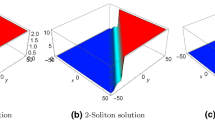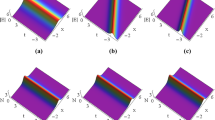Abstract
Plasmas are of current interest, supporting some nonlinear phenomena. In this paper, we investigate a three-component coupled derivative nonlinear Schrödinger system for a certain plasma. With respect to the complex envelopes of three fields in the plasma, we construct a Lax pair and obtain some soliton and breather solutions. Based on the soliton solutions, one bell-shaped soliton is presented. We present the interactions between/among the two/three bell-shaped solitons. Widths and velocities of the two solitons are unchanged after the interactions via the asymptotic analysis. When the two/three solitons have the same velocity, bound state of the two/three solitons is formed. Based on breather solutions, interaction between the Akhmediev breather (AB) and soliton, and interaction between the AB and breather-like soliton are shown. We present the interaction between the Kuznetsov–Ma breather and breather-like soliton. We investigate the modulation instability for the plane wave solutions via the linear stability analysis: If the imaginary part of \(\Omega \) exists, the modulation instability appears, where \(\Omega \) is the frequency of perturbation.





Similar content being viewed by others
Data Availability Statement
Some or all data, models, or code generated or used during the study are available from the corresponding author by request.
References
R.E. Tolba, Eur. Phys. J. Plus 136, 138 (2021)
A. Saha, P. Chatterjee, S. Banerjee, Eur. Phys. J. Plus 135, 801 (2021)
N. Cheemaa, A.R. Seadawy, S. Chen, Eur. Phys. J. Plus 134, 119 (2019)
B.S. Wettervik, M. Marklund, A. Gonoskov, Phys. Plasmas 26, 053101 (2019)
D.Y. Yang, B. Tian, M. Wang, X. Zhao, W.R. Shan, Y. Jiang, Nonlinear Dyn. (2022) (in press). https://doi.org/10.1007/s11071-021-06886-2
X.Y. Gao, Y.J. Guo, W.R. Shan, Appl. Comput. Math. 20, 421 (2021)
Y. Shen, B. Tian, X.T. Gao, Chin. J. Phys. (2022) (in press). https://doi.org/10.1016/j.cjph.2021.11.025
D. Wang, Y.T. Gao, C.C. Ding, C.Y. Zhang, Commun. Theor. Phys. 72, 115004 (2020)
X.Y. Gao, Y.J. Guo, W.R. Shan, H.M. Yin, X.X. Du, D.Y. Yang, Commun. Nonlinear Sci. Numer. Simul. 105, 106066 (2022)
R.C. Mancini, T.E. Lockard, D.C. Mayes, I.M. Hall, Phys. Rev. E 101, 051201 (2020)
X.Y. Gao, Y.J. Guo, W.R. Shan, Y.Q. Yuan, C.R. Zhang, S.S. Chen, Appl. Math. Lett. 111, 106627 (2021)
V. Jatenco-Pereira, Phys. Scr. 60, 113 (2021)
Z. Du, T. Xu, S. Ren, Nonlinear Dyn. 104, 683 (2021)
D.Y. Yang, B. Tian, C.C. Hu, S.H. Liu, W.R. Shan, Y. Jiang, Wave. Random Complex (2022) in press, https://doi.org/10.1080/17455030.2021.1983237
L. Hu, Y.T. Gao, T.T. Jia, G.F. Deng, L. Q. Li, Z. Angew. Math. Phys. 72, 75 (2021)
F.Y. Liu, Y.T. Gao, X. Yu, L.Q. Li, C.C. Ding, D.Wang, Eur. Phys. J. Plus 136, 656 (2021)
D. Wang, Y.T. Gao, X. Yu, L.Q. Li, T.T. Jia, Nonlinear Dyn. 104, 1519 (2021)
D. Wang, Y.T. Gao, J.J. Su, C.C. Ding, Mod. Phys. Lett. B 34, 2050336 (2020)
M. Wang, B. Tian, C.C. Hu, S.H. Liu, Appl. Math. Lett. 119, 106936 (2021)
M. Wang, B. Tian, T. Y. Zhou, Chaos Solitons Fract. 152, 111411 (2021)
T.Y. Zhou, B. Tian, Y.Q. Chen, Y. Shen, Nonlinear Dyn. (2022) in press. https://doi.org/10.1007/s11071-022-07211-1
Z. Du, Y.P. Ma, Appl. Math. Lett. 116, 106999 (2021)
X.Y. Gao, Y.J. Guo, W.R. Shan, Appl. Math. Lett. 120, 107161 (2021)
Y.J. Feng, Y.T. Gao, T.T. Jia, L.Q. Li, Mod. Phys. Lett. B 33, 1950354 (2019)
T.Y. Zhou, B. Tian, S.S. Chen, C.C. Wei, Y. Q. Chen, Mod. Phys. Lett. B 35, 2150421 (2021)
X.Y. Gao, Y.J. Guo, W.R. Shan, Eur. Phys. J. Plus 136, 893 (2021)
Y. Shen, B. Tian, Appl. Math. Lett. 122, 107301 (2021)
D.Y. Yang, B. Tian, Q.X. Qu, C.R. Zhang, S.S. Chen, C.C. Wei, Chaos Solitons Fract. 150, 110487 (2021)
M. Wang, B. Tian, Wave. Random Complex (2022) (in press). https://doi.org/10.1080/17455030.2021.1986649
Y. Shen, B. Tian, T.Y. Zhou, Eur. Phys. J. Plus 136, 572 (2021)
M. Wang, B. Tian, Eur. Phys. J. Plus 136, 1002 (2021)
Y.X. Ma, B. Tian, Q.X. Qu, C.C. Wei, X. Zhao, Chin. J. Phys. 73, 600 (2021)
X.Y. Gao, Y.J. Guo, W.R. Shan, Rom. Rep. Phys. 73, 111 (2021)
X.T. Gao, B. Tian, Y. Shen, C.H. Feng, Chaos Solitons Fract. 151, 111222 (2021)
L. Hu, Y.T. Gao, S.L. Jia, J.J. Su, G.F. Deng, Mod. Phys. Lett. B 33, 1950376 (2019)
X.T. Gao, B. Tian, Appl. Math. Lett. (2022) in press, https://doi.org/10.1016/j.aml.2021.107858
X.H. Wu, Y.T. Gao, X. Yu, C.C. Ding, F.Y. Liu, T.T. Jia, Mod. Phys. Lett. B (2022) in press, Ms. No. MPLB-D-21-00411
C.C. Ding, Y.T. Gao, G.F. Deng, D. Wang, Chaos Solitons Fract. 133, 109580 (2020)
F.Y. Liu, Y.T. Gao, X. Yu, L. Hu, X.H. Wu, Chaos Solitons Fract. 152, 111355 (2021)
D.Y. Yang, B. Tian, H.Y. Tian, Y.Q. Chen, W.R. Shan, Y. Jiang, Optik 247, 166815 (2021)
X.Y. Gao, Y.J. Guo, W.R. Shan, Chaos Solitons Fract. 147, 110875 (2021)
X.T. Gao, B. Tian, C.H. Feng, Chin. J. Phys. (2022) in press, https://doi.org/10.1016/j.cjph.2021.11.019
X.Y. Gao, Y.J. Guo, W.R. Shan, Commun. Theor. Phys. 72, 095002 (2020)
Y. Shen, B. Tian, C.D. Cheng, T.Y. Zhou, Eur. Phys. J. Plus 136, 1159 (2021)
Y. Shen, B. Tian, S.H. Liu, Phys. Lett. A 405, 127429 (2021)
Y.X. Ma, B. Tian, Q.X. Qu, D.Y. Yang, Y.Q. Chen, Int. J. Mod. Phys. B 35, 2150108 (2021)
L.Q. Li, Y.T. Gao, L. Hu, T.T. Jia, C.C. Ding, Y.J. Feng, Nonlinear Dyn. 100, 2729 (2020)
C.C. Ding, Y.T. Gao, L. Hu, G.F. Deng, C.Y. Zhang, Chaos Solitons Fract. 142, 110363 (2021)
F.Y. Liu, Y.T. Gao, X. Yu, C.C. Ding, G.F. Deng, T.T. Jia, Chaos Solitons Fract. 144, 110559 (2021)
L.Q. Li, Y.T. Gao, X. Yu, T.T. Jia, L. Hu, C.Y. Zhang, Chin. J. Phys. (2022) in press, https://doi.org/10.1016/j.cjph.2021.09.004
H.H. Chen, Y.C. Lee, C.S. Liu, Phys. Scr. 20, 490 (1979)
A. Hussain, A. Jhangeer, S. Tahir, Y.M. Chu, I. Khan, K.S. Nisar, Results Phys. 18, 103208 (2020)
V.S. Gerdjikov, M.I. Ivanov, Bulg. J. Phys. 10, 130 (1983)
C.C. Ding, Y.T. Gao, L.Q. Li, Chaos Soliton Fract. 120, 259 (2019)
A. Kundu, J. Math. Phys. 25, 3433 (1984)
T. Xu, Y. Chen, Nonlinear Dyn. 92, 2133 (2018)
H.C. Morris, R.K. Dodd, Phys. Scr. 20, 505 (1979)
L.M. Ling, Q.P. Liu, J. Phys. A 43, 434023 (2010)
L.J. Guo, L.H. Wang, Y. Cheng, J.S. He, Commun. Nonlinear Sci. Numer. Simul. 79, 104915 (2019)
T. Xu, G.L. He, Nonlinear Dyn. 100, 2823 (2020)
K. Mio, T. Ogino, K. Minami, S. Taketa, J. Phys. Soc. Jpn. 41, 265 (1976)
E. Mjølhus, J. Plasma Phys. 16, 321 (1976)
E. Mjølhus, J. Plasma Phys. 19, 437 (1978)
M.S. Ruderman, J. Plasma Phys. 67, 271 (2002)
V. Fedun, M.S. Ruderman, R. Erdelyi, Phys. Lett. A 372, 6107 (2008)
M.J. Ablowitz, B. Prinari, A.D. Trubatch, Discrete and Continuous Nonlinear Schrödinger Systems (Cambridge Univ. Press, Cambridge, 2004)
Acknowledgements
We express our sincere thanks to the Editors and Reviewers for their valuable comments. This work has been supported by the National Natural Science Foundation of China under Grant Nos. 11772017, 11272023 and 11471050, by the Fund of State Key Laboratory of Information Photonics and Optical Communications (Beijing University of Posts and Telecommunications), China (IPOC: 2017ZZ05) and by the Fundamental Research Funds for the Central Universities of China under Grant No. 2011BUPTYB02.
Author information
Authors and Affiliations
Corresponding author
Appendix
Appendix
We will study the MI for Eq. (3) via the linear stability analysis. Setting the plane wave solution \(v[0]={\hat{\kappa }}e^{i\left[ {\hat{\omega }} \xi +\frac{1}{3}{\hat{\omega }}(2{{\hat{\kappa }}}^2\epsilon -3{\hat{\omega }})\varsigma \right] }\), we consider the solutions to be the following form:
where \({\hat{\varrho }}\) is a small parameter, \({\hat{u}}\) is a function with respect to \(\xi \) and \(\varsigma \), \({\hat{\omega }}\ne 0\) and \({\hat{\kappa }}\) are real constants. Taking Expression (26) into Eq. (3) can produce the linear system of \({\hat{u}}\) at \(O({\hat{\varrho }})\) as
Then, we set that
where \({\hat{\sigma }}_{11}(\varsigma )\) and \({\hat{\sigma }}_{12}(\varsigma )\) are the functions of \(\varsigma \), \({\hat{\Lambda }}\) is the wave number and \({\hat{\Omega }}\) is the frequency of perturbation. Taking Solution (28) into Eq. (27), we acquire that
where \({\hat{\Upsilon }}=({\hat{\sigma }}_{11}(\varsigma ),~{\hat{\sigma }}_{12}(\varsigma ))^T\). The matrix \({\hat{D}}\) can be acquired as
It is easy to see that we get two roots via solving the characteristic equation of the matrix \({\hat{D}}\) as
If the characteristic equation of \({\hat{D}}\) has two real roots, thence the solutions are modulationally stable; if the characteristic equation of \({\hat{D}}\) has one pair of the complex conjugate roots. One of this pair of the conjugate complex roots has a negative imaginary part, and accordingly System (1) exhibits the baseband MI. Growth rates of the instability for Eq. (3) and System (1) are different.
Rights and permissions
About this article
Cite this article
Yang, DY., Tian, B., Qu, QX. et al. Lax pair, solitons, breathers and modulation instability of a three-component coupled derivative nonlinear Schrödinger system for a plasma. Eur. Phys. J. Plus 137, 189 (2022). https://doi.org/10.1140/epjp/s13360-021-02287-x
Received:
Accepted:
Published:
DOI: https://doi.org/10.1140/epjp/s13360-021-02287-x




